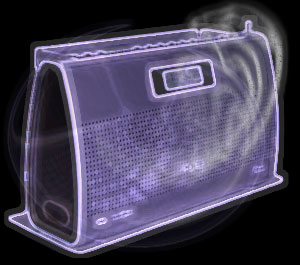Radio broadcasting is an audio (sound) broadcasting service, traditionally broadcast through the air as radio waves (a form of electromagnetic radiation) from a transmitter to an antenna and a thus to a receiving device. Stations can be linked in radio networks to broadcast common programming, either in syndication or simulcast or both. Audio broadcasting also can be done via cable FM, local wire networks, satellite and the Internet.
History
Radio stations are of several types. The best known are the AM and FM stations; these include both commercial, public and nonprofit varieties as well as student-run campus radio stations and hospital radio stations can be found throughout the developed world.
Although now being eclipsed by internet-distributed radio, there are many stations that broadcast on shortwave bands using AM technology that can be received over thousands of miles (especially at night). For example, the BBC has a full schedule transmitted via shortwave. These broadcasts are very sensitive to atmospheric conditions and sunspots.
 Types
TypesAM stations were the earliest broadcasting stations to be developed. AM refers to amplitude modulation, a mode of broadcasting radio waves by varying the amplitude of the carrier signal in response to the amplitude of the signal to be transmitted.
One of the advantages of AM is that its unsophisticated signal can be detected (turned into sound) with simple equipment. If a signal is strong enough, not even a power source is needed; building an unpowered crystal radio receiver was a common childhood project in the early years of radio.
AM broadcasts occur on North American airwaves in the mediumwave frequency range of 530 to 1700 kHz (known as the "standard broadcast band"). The band was expanded in the 1990s by adding nine channels from 1620 to 1700 kHz. Channels are spaced every 10 kHz in the Americas, and generally every 9 kHz everywhere else.
Many countries outside of the U.S. use a similar frequency band for AM transmissions. Europe also uses the longwave band. In response to the growing popularity of FM radio stations in the late 1980s and early 1990s, some North American stations began broadcasting in AM stereo, though this never really gained acceptance.
AM radio has some serious shortcomings.
AM signals exhibit diurnal variation, travelling much longer distances at night. In a crowded channel environment this means that the power of regional channels which share a frequency must be reduced at night or directionally beamed in order to avoid interference, which reduces the potential nighttime audience. Some stations have frequencies unshared with other stations in the U.S.; these are called clear channel stations. Many of them can be heard across much of the country at night. (This is not to be confused with Clear Channel Communications, which currently owns many U.S. radio stations.)
The signal is subject to interference from electrical storms (lightning) and other EMI.
Fading of the signal can be severe at night.
AM radio transmitters can transmit audio frequencies up to 20 kHz (now limited to 10 kHz in the US due to FCC rules designed to reduce interference), but most receivers are only capable of reproducing frequencies up to 5 kHz or less. At the time that AM broadcasting began in the 1920s, this provided adequate fidelity for existing microphones, 78 rpm recordings, and loudspeakers. The fidelity of sound equipment subsequently improved considerably but the receivers did not. Reducing the bandwidth of the receivers reduces the cost of manufacturing and makes them less prone to interference. In the United States, AM stations are never assigned adjacent channels in the same service area. This prevents the sideband energy generated by two stations from interfering with each other. Bob Carver created an AM stereo tuner employing notch filtering that demonstrated an AM broadcast can meet or exceed the 15 kHz bandwidth of FM stations without objectionable interference. After a few years the tuner was discontinued; Bob Carver had left the company and Carver Corporation later cut the number of models produced before discontinuing production completely. AM stereo broadcasts declined with the advent of HD Radio. FM
Digital radio broadcasting has emerged, first in Europe (the UK in 1995 and Germany in 1999), and later in the United States. The European system is named DAB, for Digital Audio Broadcasting, and uses the public domain EUREKA 147 system. In the United States, the IBOC system is named HD Radio and owned by a consortium of private companies called iBiquity. An international non-profit consortium Digital Radio Mondiale (DRM), has introduced the public domain DRM system.
It is expected that for the next 10 to 20 years, all these systems will co-exist, while by 2015 to 2020 digital radio may predominate, at least in the developed countries.
Digital
Satellite radiobroadcasters are slowly emerging, but the enormous entry costs of space-based satellite transmitters, and restrictions on available radio spectrum licenses has restricted growth of this market. In the USA and Canada, just two services, XM Satellite Radio and Sirius Satellite Radio exist.
Satellite
Many other non-broadcast types of radio stations exist. These include:
base stations for police, fire and ambulance networks
military base stations
dispatch base stations for taxis, trucks, and couriers
emergency broadcast systems
amateur radio stations Other